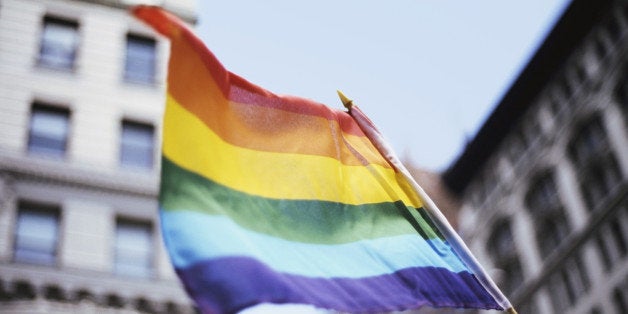
A stand-up comedian that I work with from time-to-time once asked: When did gays get the rainbow?
Interesting question, although I'm not entirely sure we "have it." It's not like anyone buys a box of Lucky Charms and thinks the leprechaun is LGBTQ.
Still, as a teacher who's hung a giant rainbow flag in my classroom, I know it is a powerful icon. Students see it and immediately know the values I stand for. I get questions about my understanding of, and comments about, LGBTQ issues they consider important. Not one has said, "I love that cereal!"
So this got me thinking: When did the rainbow flag become synonymous with LGBTQ equality? And what about other symbols and words?
When you hear the word "pride," you immediately think of a giant LGBTQ celebration. Is this one as predominant as the rainbow flag? No. When people watch the "Lion King" I'm pretty sure they don't think Simba and his pride of lions are having a gay celebration. This may explain why there is, alas, no "Kenya Pride." (That and rampant homophobia by the country's leaders.)
Thinking about rainbows and Pride, I figured that the origins of both concepts as LGBTQ symbols would be buried somewhere in the dustbin of history. Sort of like "OK," which no one really knows where it came from. (It's thought to be a Boston abbreviation, or something from the Choctaw Native Americans. Or maybe it's a West African expression. Or Scottish, or Lakota or Greek.) Sometimes it's fun to be wrong.
The Rainbow flag started in San Francisco, in 1970, by a guy named Gilbert Baker. There, he met Harvey Milk, a member of the city's Board of Supervisors. (Interesting that one of the world's most colorful cities should have such a boring title for the people that run it.) Harvey encouraged Gilbert to create a positive symbol for LGBTQ people to rally around. The rainbow flag was born - sort of. The first flag had eight stripes, including the six we know today: red for life, orange for healing, yellow for the sun, green for nature, indigo for harmony and violet for spirit. It also, however, contained hot pink for sexuality and turquoise blue for art.
The fuchsia color disappeared when Gilbert decided to mass produce his original homemade flag. Unlike the Eighties, when everyone from Olivia Newton-John to 30-year-old suburban housewives were wearing fuchsia on everything from leg-warmers to eye shadow, fuchsia flag fabric was pretty much impossible to find in the Seventies. Therefore, the color was eliminated and the seven-striped version was born.
The loss of turquoise from the flag has a far more somber cause. In 1978, the mayor of San Francisco and Harvey Milk were assassinated. In response, gay activists dropped the turquoise color from the rainbow flag so the remaining six colors could be split in half and flown on both sides of the street in their honor during the 1979 Gay Freedom parade.
Pink, however, has remained part of the LGBTQ fold in other ways in the form of the pink triangle. Its start was not nearly as kind as the flag, however, as it was the symbol used by the Nazis to identify LGBTQ people during the Holocaust.
Like more than a half-dozen groups, LGBTQ people were targeted for harassment, imprisonment and execution before and during the Holocaust. Each of these groups got its own color triangle, so they could be identified from a distance.
The pink triangles were larger than the other groups' triangles. That made them easier for their oppressors to find. Worse, when the guards were done abusing their prisoners, other inmates often set upon them as well. After the war, many were even returned to prison for the "crime" of being LGBTQ.
Perhaps that's why three-quarters of a century later, LGBTQ people have not only taken the symbol back, but use it as a symbol to fight oppression. When displayed, the Pink Triangle is used to encourage discussion about how to prevent LGBTQ hate crimes.
The use of Pride in terms of LGBTQ celebrations also has its roots in tragedy.
Following New York City's Stonewall Riots in June, 1969, a group of LGBTQ leaders came together to propose the nation's first gay pride parade. Held exactly one year after the riots, on June 28, 1970, it was called the Christopher Street Liberation Day.
Now, if you are a careful reader, you will notice the word "Pride" is nowhere in that title. If you did not notice that, I am deeply concerned for you.
Even so, this is where the concept of Pride in an LGBTQ context was born. As the event was being planned, LGBT leaders frequently used and popularized the word "pride" to describe the festivities. The woman who coordinated the march is, to this day, known as "The Mother of Pride."
By the 1980s, "Pride" was frequently being used to identify LGBTQ celebrations.
Today, there are Pride celebrations literally all over the world. And while there might not be any in Kenya, there are celebrations in other parts of Africa, like South Africa and Uganda. Indeed, there are now hundreds of celebrations in dozens of nations, covering six of the seven continents.
Fortunately, there's even good news from Antarctica. There, the University of Antarctica hosts an LGBTQ Resource Center, although it's still unknown if the LGBTQ community there will be hosting a parade. Given the apparel many people wear in Pride parades, it's thought a lot of people might freeze to death. (And yes, this appears to be a real university. Although I have to admit, since it's not on Wikipedia, I do wonder.)
The good news is Antarctica is full of penguins, many of whom might be gay. More, given the remarkable organizational skills they've showed in a variety of documentaries and animated films, it's probably only a matter of time until they start an LGBTQ march of the penguins.
